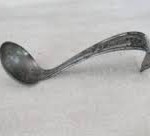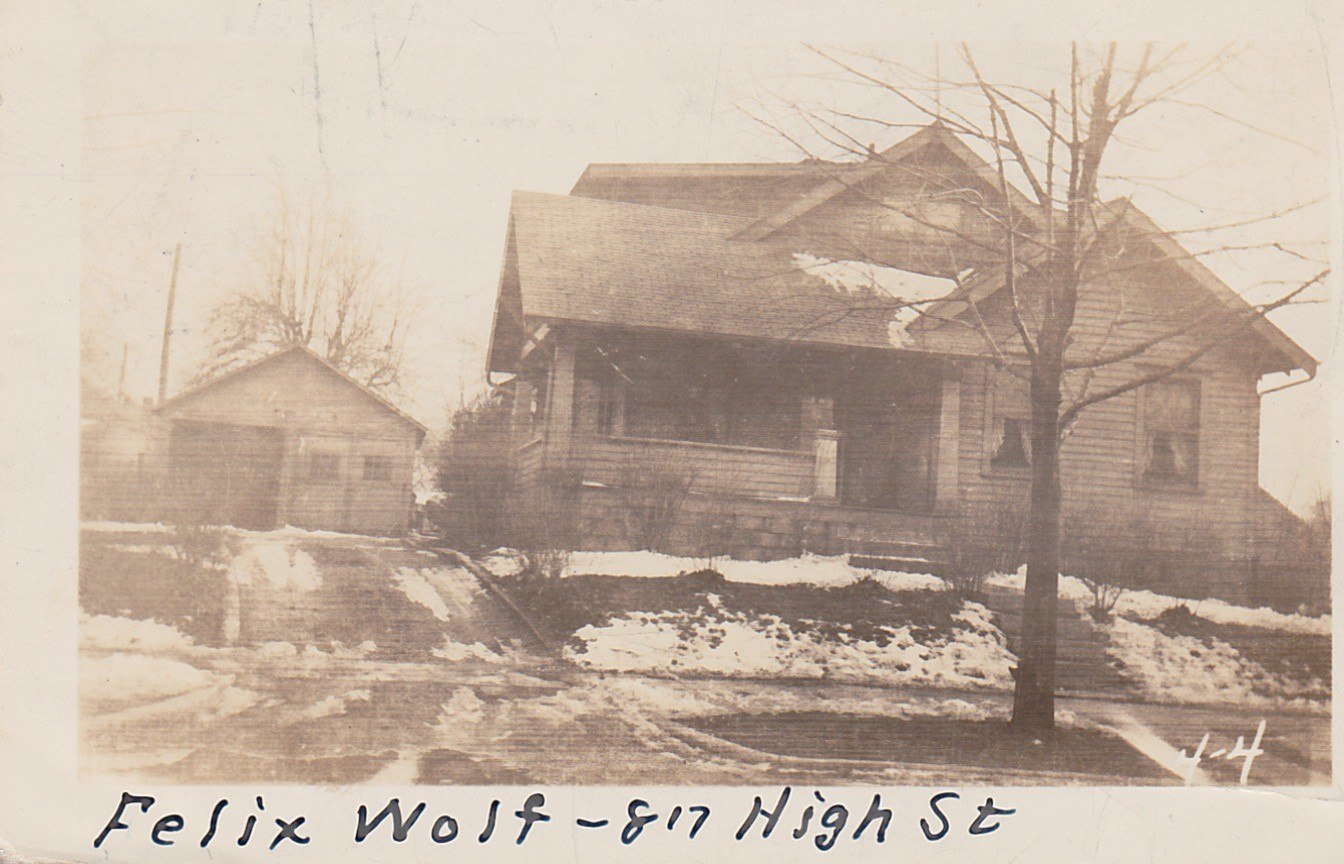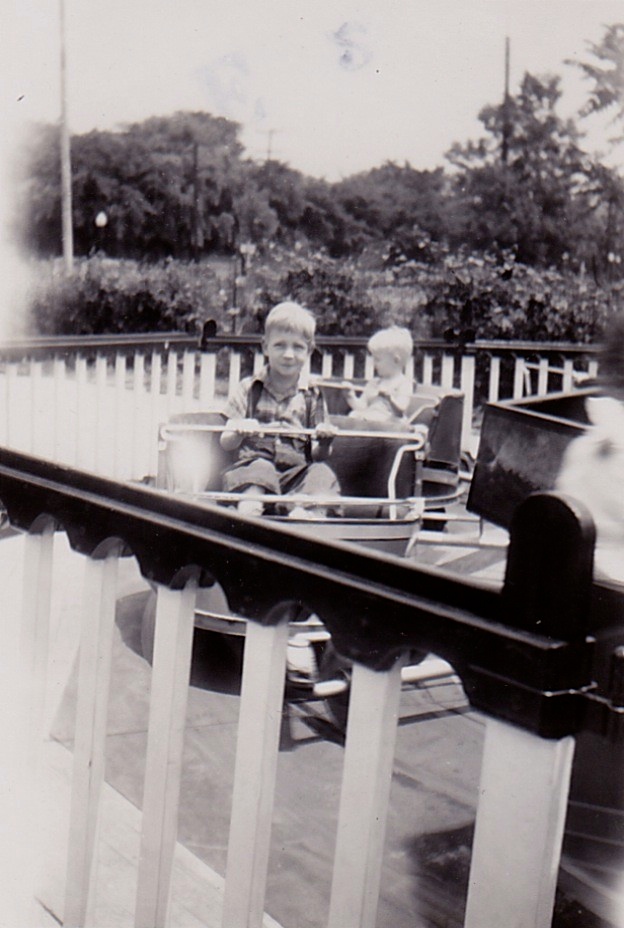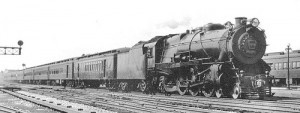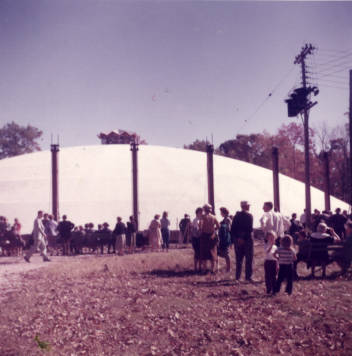1947 THE WAY I REMEMBER THOSE PRE-SCHOOL YEARS
I spent a great deal of my life growing up on High Street, because Grandma Wolff volunteered to baby sit while Mother and Dad worked. Grandma worked at the G.T. when she got married, but turned full time housekeeper and mother when her boys were born. I think she preferred this life at home. My cousins and I were in and out of her life from time to time, but I was always around the most.

Some of my earliest recollections are of the coming and goings of the various delivery people and street vendors of the day. The shortest lived, I would guess, was the ice man. He would park his ice truck in the street, and while he made deliveries in the neighborhood, all of us kids would run up to the back and get a treat of ice chips on a hot summer day. The primary purpose of the delivery was to resupply the kitchen ice boxes with block ice. The ice man used tongs to grab the block and typically carried it over his shoulder, covered by a leather sheath. He would enter the house and place it directly in the ice box.
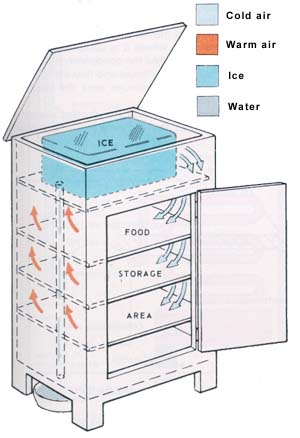
We were still using the ice box because, Grandpa Wolff, having the practical and conservative German upbringing, believed if it wasn`t broken, don`t fix it and if something still served the purpose an upgrade was not needed! Yes, and the theory of the ice box still worked, at least for another year maybe. My job was to empty the drip pan, located under the box, as I was reminded from time to time. And of course, wipe up the spills!
Here is an interesting story of how one ice company adapted to the changing technology. By the 1920s the growth of refrigerators created competition for the ice trade and ice companies began looking for alternative markets. Joe C. Thompson, an employee of Southland Ice Company supplemented ice sales in his ice distribution shops by selling milk, eggs and other items he kept cool with the ice he was distributing. His shops opened early at 7 am and stayed open till 11 pm so that working customers could pick up their blocks of ice. As the market shifted from ice to convenience items his shops were renamed Seven-Eleven in 1952.
 Another summertime vendor was the popsicle boy. He would peddle his tricycle cooler with dry ice in the compartment around the neighborhoods and sell ice cream bars and two stick popsicles, so they could be broken and shared with a friend. All for a nickel!
Another summertime vendor was the popsicle boy. He would peddle his tricycle cooler with dry ice in the compartment around the neighborhoods and sell ice cream bars and two stick popsicles, so they could be broken and shared with a friend. All for a nickel!
Of course, there was the year-round milk man who would get our order via a note, left in the return bottles we set out the night before. We could get milk, cream, cheese, sour cream and cottage cheese delivered to our door twice a week.
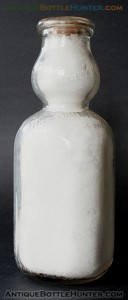
We had an option for the type of milk to be delivered. Other than the regular homogenized milk, we could get cream milk. This came in a different bottle configuration so that the cream could rise to the top and be dipped out prior to using the milk. A special dipper was provided to accommodate the shape of the bottle neck.
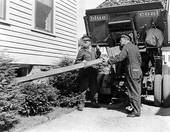
One delivery was only made in the fall and winter, the coal man. The coal truck would pull onto the driveway, next to the coal chute which was built into the foundation of the basement. The coal was transferred down the chute to the coal bin in the basement. My job was to collect the scattered pieces of coal and return them to the bin. This was usually followed by a mandatory bath and change of clothes.

This brings us to laundry day, which was every Monday. And I mean EVERY Monday. Rainy day, clothes were hung in the basement and on sunny days, they were carried up the stairs and hung outside. We had a wringer washer, which Grandpa had recently upgraded to a motor driven wringer.
The wringer got its` name from the old method of actually twisting and wringing the excess water from the clothes. So, when the two rollers were invented to squeeze the water out, the process was still called wringing, much like the name ice box carried over to the refrigerator.
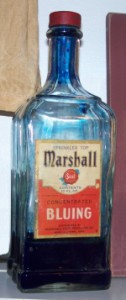
The washer was set up next to a rinse tub that often contain an additive called bluing. It was discovered that the mind`s eye perceives white in a different way from most colors. With just a slight hint of a blue tint, a white garment is perceived to actually be whiter. So, my chore was to, very carefully, add just the exact number of drops into the rinse water.
Grandma still had a delicate cycle she would use with the wringer and bluing rinse,.. her old wash board!
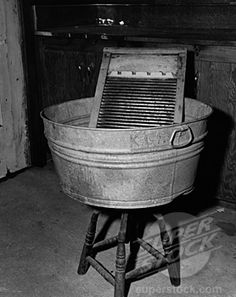
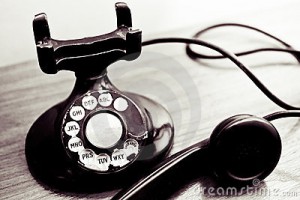
Another convenience that would chance drastically over the next decades…the telephone. Many rural areas were still using the old model crank handle phones, but in town, we had the new rotary dial desk phone. Most everyone had a party line where four to five families would share the same line, but have distinctive rings.
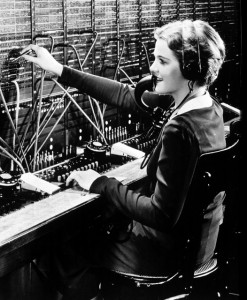 Dialing “0” would connect us to an operator who could direct connect us to a person or business whose number we did not know. When making a call out of our area we had to request a long distance operator. The operator would ask if the call was direct, which meant we would talk to whoever answered, or person to person, which required a certain person to answer. There was an extra charge for a long distance call and we then had the option to ask for the charges to be reversed, which the callee could refuse. This was a great system and we never dreamed of the advances yet to be made in the area of communications!
Dialing “0” would connect us to an operator who could direct connect us to a person or business whose number we did not know. When making a call out of our area we had to request a long distance operator. The operator would ask if the call was direct, which meant we would talk to whoever answered, or person to person, which required a certain person to answer. There was an extra charge for a long distance call and we then had the option to ask for the charges to be reversed, which the callee could refuse. This was a great system and we never dreamed of the advances yet to be made in the area of communications!
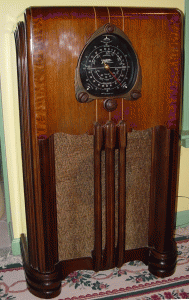
Speaking of communications, radio was king and the main form of news and entertainment. The old-time radio era, sometimes referred to as the Golden Age of Radio, refers to a period of radio programming in the United States lasting from the proliferation of radio broadcasting in the early 1920s until the 1950s, when television superseded radio as the medium of choice for scripted programming and radio shifted to playing popular music. During this period, when radio was dominant and filled with a variety of formats and genres, people regularly tuned into their favorite radio programs.
The major networks were:
National Broadcasting Company (NBC), a development by the Radio Corporation of America (RCA), 1926
Columbia Broadcasting System (CBS), 1927
Mutual Broadcasting System, developed from four different stations. Unlike the other networks, it did not own stations, 1934
American Broadcasting Company (ABC), developed from an anti-monopoly sell-off of an NBC division, 1945
In 1947, Grandma Wolff`s favorites shows were the soaps. Early radio series such as Ma Perkins were broadcast in weekday daytime slots, usually five days a week, when most of the listeners would be housewives; thus, the shows were aimed at and consumed by a predominantly female audience. The name, “soap” refers to the soap and detergent commercials originally broadcast during the shows, which were aimed at women who were cleaning their houses at the time of listening or viewing, and “opera” refers to the melodramatic character of the shows.
Originally serials were broadcast as fifteen-minute installments each weekday in daytime slots. When the soaps started, usually after lunch, Grandma would shut off the sweeper, make a pot of green tea and take a break to listen to her favorites. If I was crafty and pesky, Grandma would bribe me with some sugar cubes to go outside and play!
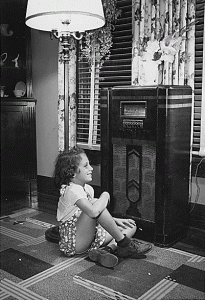
In the late afternoon and early evening hours, it was time for the dramas, news and adventure series to be broadcast. Kids would gather around the radio and “watch” their favorite heroes. I liked The Roy Rogers Show, Sky King and The Shadow. The line-up of late afternoon adventure serials included Bobby Benson and the B-Bar-B Riders, The Cisco Kid, Jack Armstrong, the All-American Boy, Captain Midnight, and The Tom Mix Ralston Straight Shooters. Badges, rings, decoding devices and other radio premiums offered on these adventure shows were often allied with a sponsor’s product, requiring the young listeners to mail in a boxtop from a breakfast cereal or other proof of purchase. Remember the Little Orphan Annie decoder ring?
ACTIVITIES OUTSIDE THE HOUSE
Another maneuver to gain peace and quiet for her soaps was to say it was nap time. I never felt that naps did anything but burn daylight that I wanted to use playing. So, on many such occasions, I would sneak upstairs and climb out the dormer window over the kitchen sink and onto the roof. From there, I would make my way to the back of the house and climb down a large maple tree. I could go play for an hour or so and then sneak back in. I don`t recall ever getting caught, but i`m sure I did.
My playgrounds were the Anderson College campus, Maplewood Cemetery, the Amick Monument Company sand piles and a big vacant lot down the street. Once in a while, I could walk down to the grocery on 8th Street and get a soda pop for a nickel. We never had soda or candy in the house for snacks. But, we usually had ,made from scratch, three layer cake, fresh fruit pie and always molasses, peanut butter or oatmeal raison cookies!
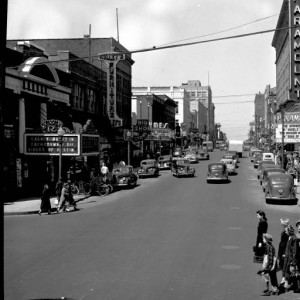
In this view of Anderson’ s Meridian Street, taken from Twelfth and Meridian, three movie theaters–the Times, the Rivieria and the Paramount–are visible. Less than a block south is the State Theater.
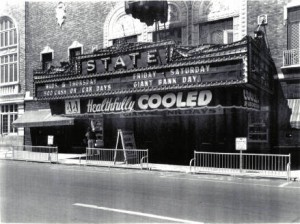
Grandma also enjoyed the movies and would take me to watch double features at the theaters downtown. She would even go see westerns with me. Air conditioned theaters were just starting to get popular and I think the operators would try to outdo each other on how cold they could get their theaters. After a double feature and cartoon, I would go outside to the sun and heat and have an immediate brain freeze headache! Note the bicycle racks on the street. We never worried about locking our bikes.
When we went out to play, we didn`t need a watch, because we went out right after breakfast and the downtown noon whistle would blow for lunch. Then, back out till the street lights came on and then we were on the front porches, visiting with family. We didn`t need bottled water, because every house had a black rubber water hose coiled up on the side of the house for anybody to use. We didn`t need baby sitters, because everyone in the neighborhood was watching out for us. It was like growing up in Mayberry!
We celebrated Easter with Grandpa and Grandma Wolff on High Street this year. Later we went to Shadyside for Easter Services.
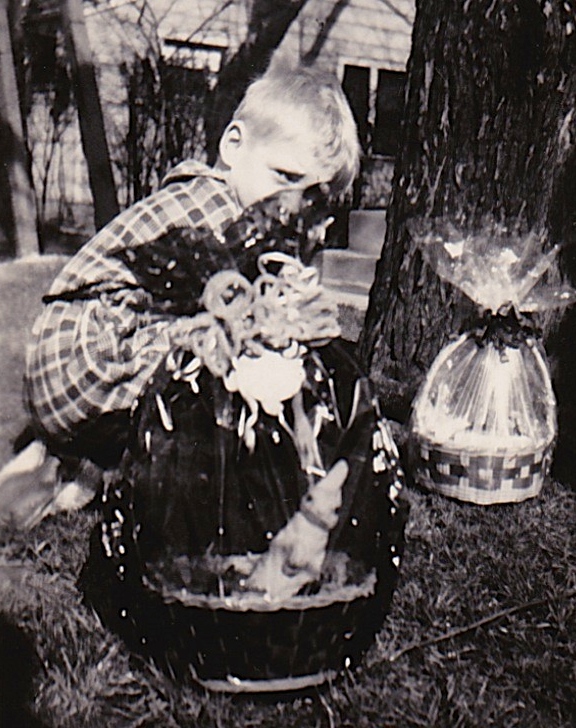
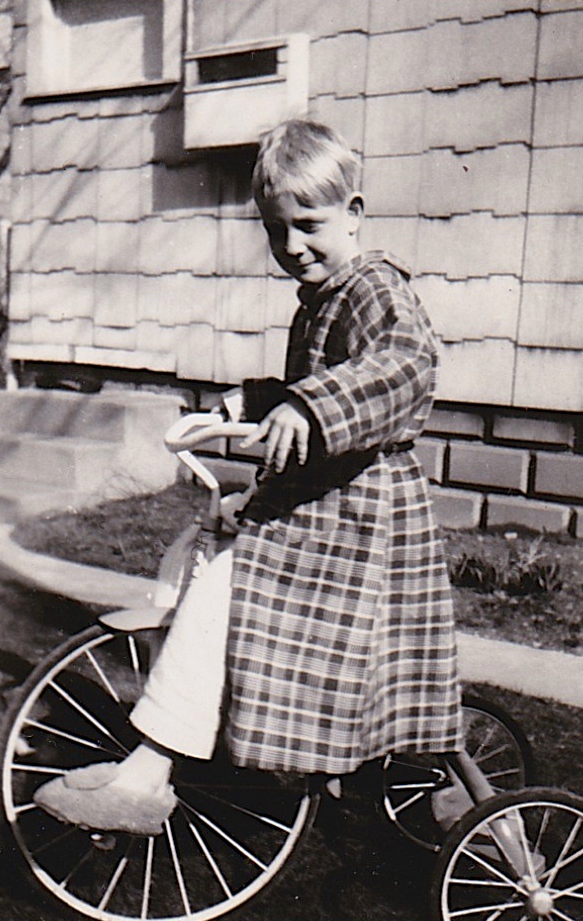
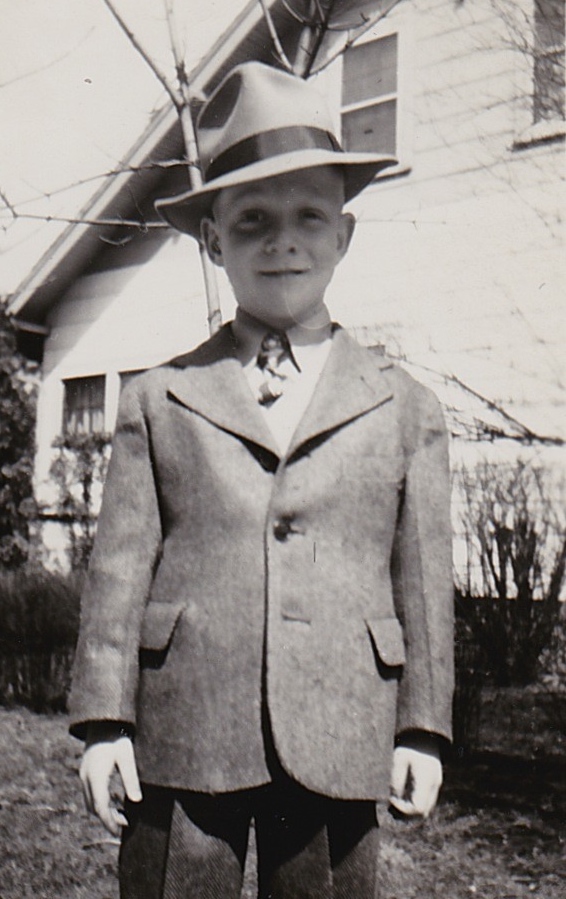
Every summer, the carnival would come to town and set up at Athletic Park in Park Place. It was called the Free Fair. They had side shows, motorcycle barrel riders, freak shows, games and many exciting rides.
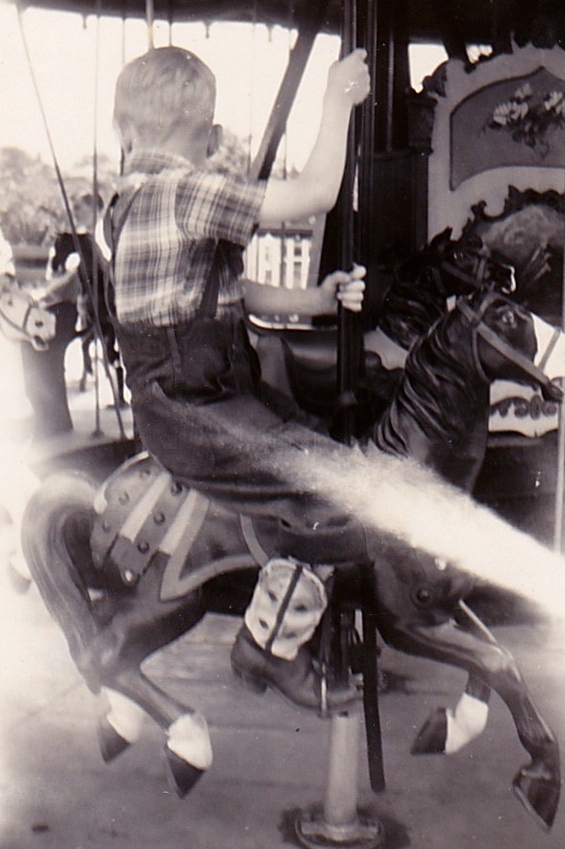
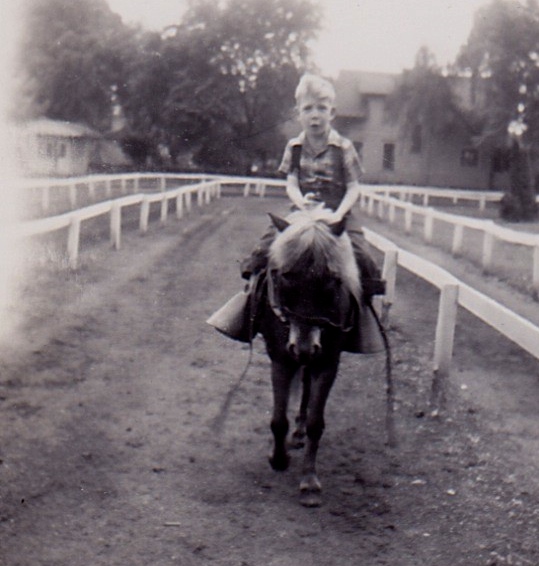
For my fifth birthday, we went to Clifty Falls State Park in Madison, Indiana.

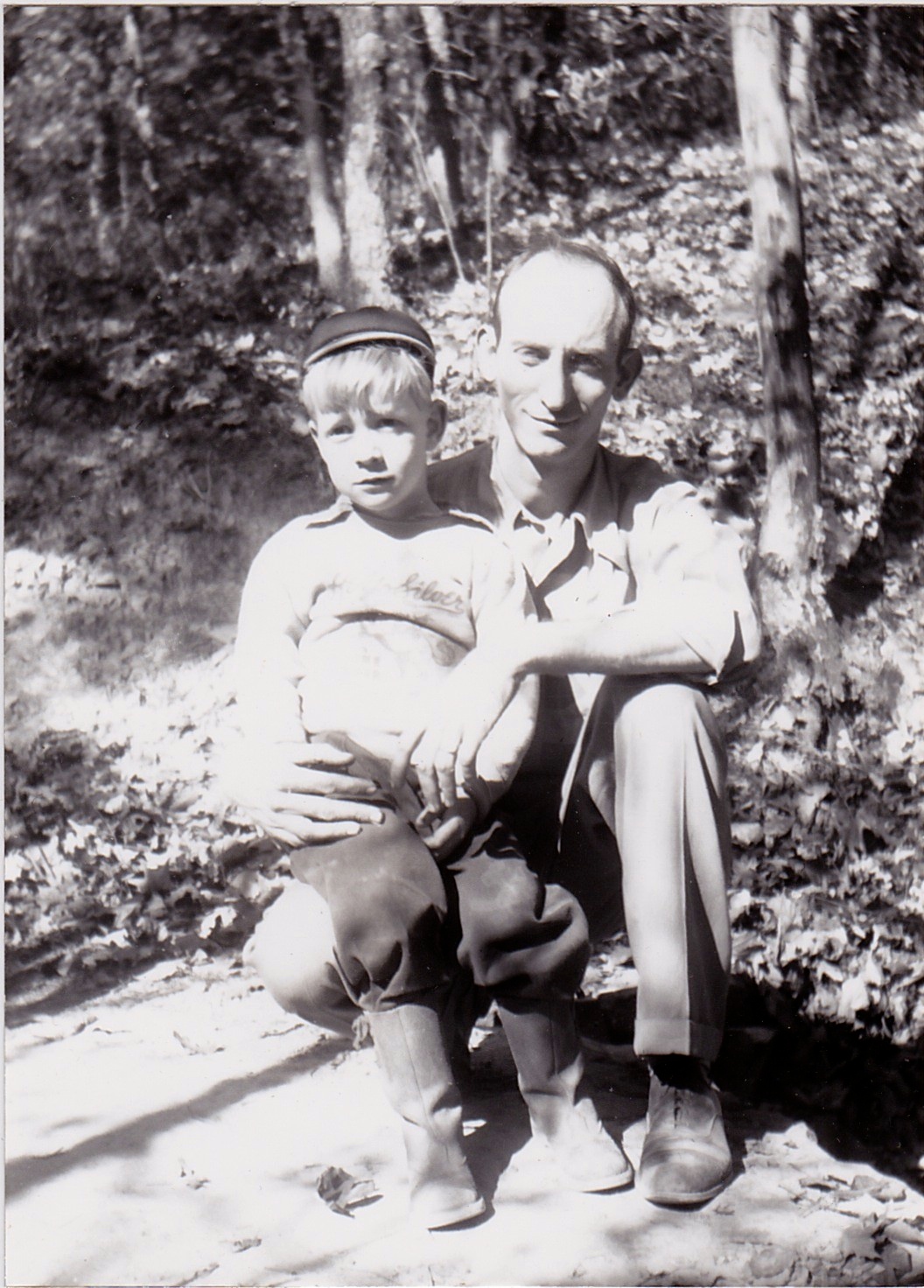
The Athletic Park swimming pool was another great summer attraction. It had locker baskets in the changing rooms which were built in around the base of the pool.

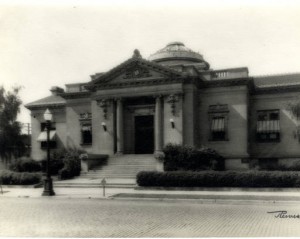
I was introduced to the library and books at an early age and enjoyed making the trip into town to visit the Anderson Public Library, which was located in the Carnegie Building at 10th and Jackson Street. The library established a special room which catered to children`s activities and was named The Peter Pan Room. The Peter Pan Room was designed for children to use. Note the national flags hanging from the pipes as a decoration and the reading benches by the fireplace. At this time, the Peter Pan Room was located in the east wing of the Carnegie building…
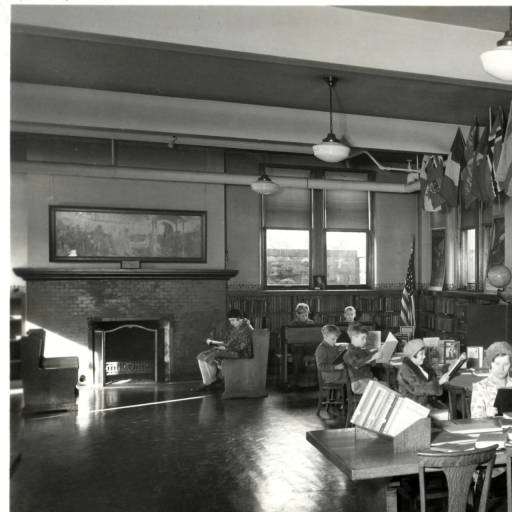
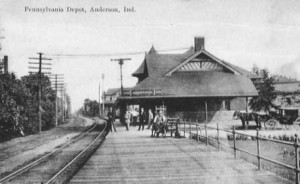
Another downtown location often visited was the Pennsylvania Rail Road Depot. This is where we would catch the train to Chicago for our many visits to Grandpa and Grandma Barrett`s house. The Pennsylvania Railroad Station in Anderson, located at 9th and Fletcher, handled freight and passengers into the 1960’s.
This is a Pennsylvania Railroad K 4 class Pacific steam locomotive on a passenger train. Most of the locomotives were still steam powered at this time and the train required that a caboose car be on 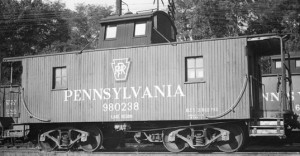 the end of the train to accommodate the brakeman and crew.
the end of the train to accommodate the brakeman and crew.
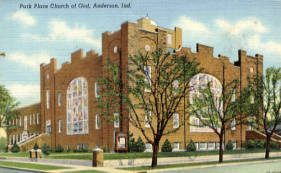
Of course, a regular Sunday event was church service at the Park Place Church of God. Grandpa and Grandma Wolff were very instramental in establishing the early church through their work with the Gospel Trumpet and starting of the Anderson Bible Training School College.
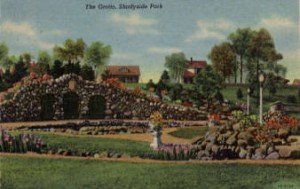
As was noted before, we spent many afternoons at Shadyside Park which was Anderson’s largest city park. It was dedicated in 1923 and the grotto, a stone structure in the park’s valley, is home to one of Anderson’s most persistent legends. Many people claim that bears were kept caged in the grotto caves , but no photos support the legend.
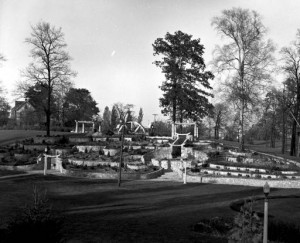 The Japanese Gardens, which are visible from Broadway, are one of Shadyside`s most attractive features. The park is used for many community functions and we attended Easter Sunrise Services this year. The Japanese Gardens provide the backdrop.
The Japanese Gardens, which are visible from Broadway, are one of Shadyside`s most attractive features. The park is used for many community functions and we attended Easter Sunrise Services this year. The Japanese Gardens provide the backdrop.
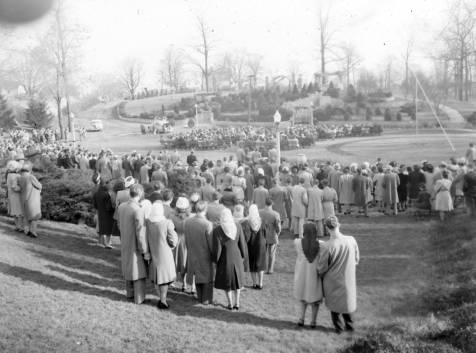
Lastly, one of our main playgrounds in summer or winter, Anderson College. Church of God leaders felt drawn to an unused parcel of land in Park Place between Third and Fifth Streets, bordered by Union (later College Ave) when they visited Anderson in 1905. This three-story was the first building on that property. It became known as Old Main and housed the Gospel Trumpet staff. In 1931, the building was given to Anderson College. Old Main became the home of Anderson Bible Training School and was for many years its only chief, serving as dormitory, cafeteria, library and classrooms. It was torn down and replaced in 1970, with Decker Hall.
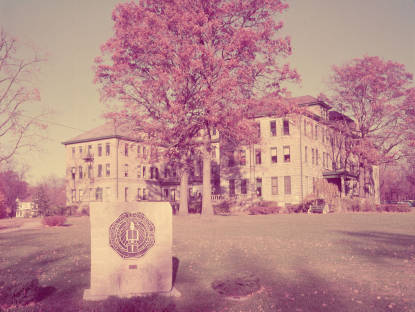
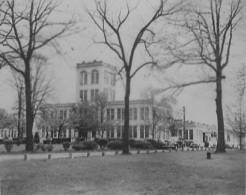
The Gospel Trumpet Company was the publishing organization of the Church of God. This buidling, located at 1200 E. Fifth Street in Park Place, opened in 1909. The Gospel Trumpet was later renamed Warner Press.
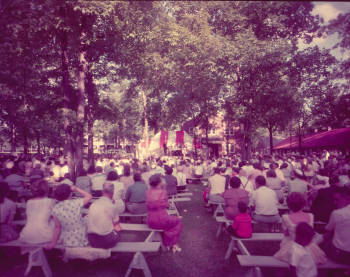
The outdoor service at Church of God campmeeting (later called International Convention) on Anderson College grounds, provided us with the challenge of collecting as many mementoes and souvenirs as we could. Combs, nail files, mirrors, hand fans, bookmarks, mottos, maps and tracts, were just a few of the many treats awaiting our adventure.
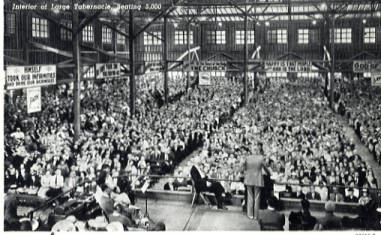
The originalTabernacle, later called Warner Auditorium. was used during inclement weather for Camp Meeting Service. The Tabernacle was torn down after heavy snow damaged the roof in March 1960. Following is a sequence of three pictures of the raising of the 3,000,000 lb. concrete dome of Warner Auditorium on the Anderson College campus, Oct. 17, 1961
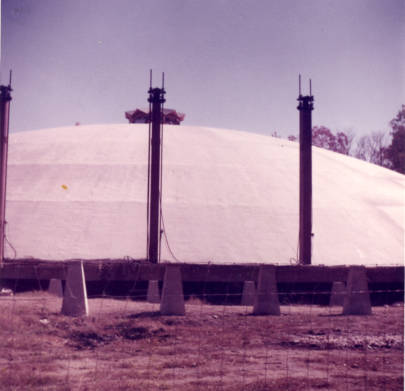
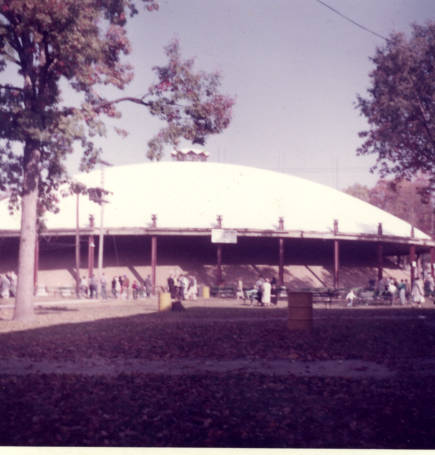
In the winter, the campus was our sledding course. At the bottom of a hill was a small stone walk bridge. It provided access across a small drainage bed. Next to the bridge was planted a large thorny bush which spread out on top to touch the stone bridge. But on the bottom of the bush, there was just enough width for a well aimed sled to squeak through. This naturally presented an irresistible challenge to us and our Flexible Flyer sleds! Many a sledder had to roll off at the last second to avoid a head on with the bridge. Then, there were those of us that had to explain our ripped and tattered clothing, after having conquered the dredded thorn bush and successfully sped through the tiny passageway!
That goal must have developed as a rite of passage, a long time ago, because when I was recalling that deed to my Dad in later years, he said they tried the same stunt when he was a kid! So goes the circle of life and so goes the continued story of The Wolff`s Den!

